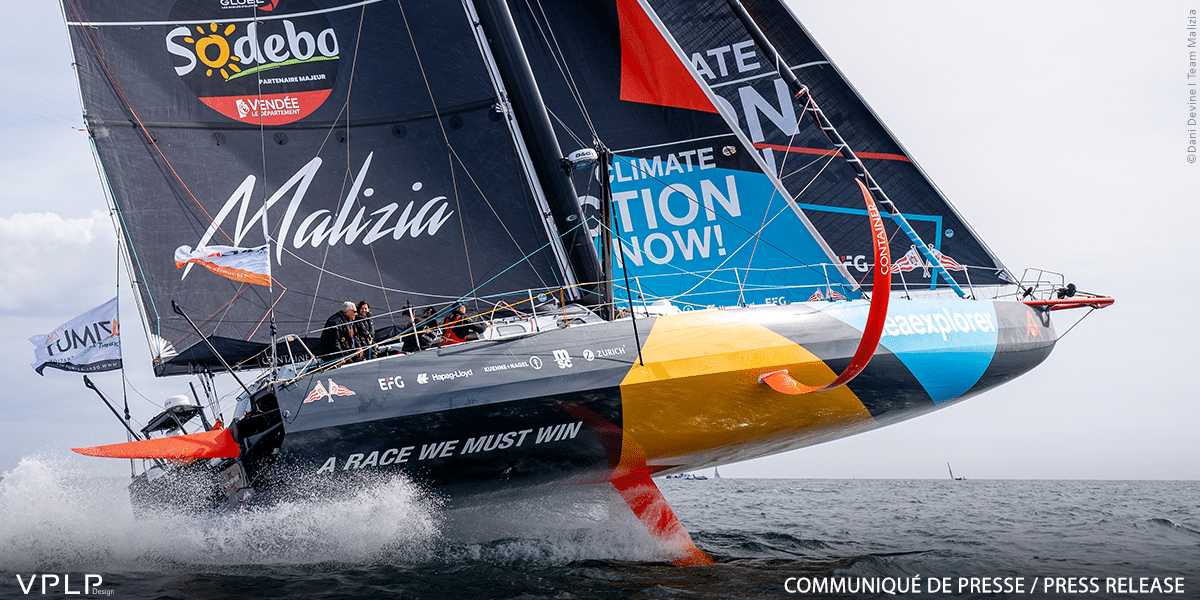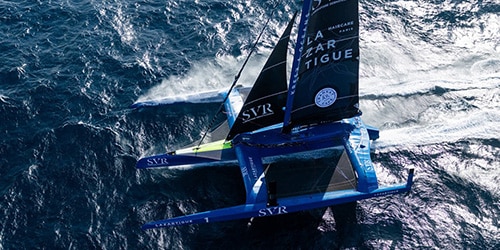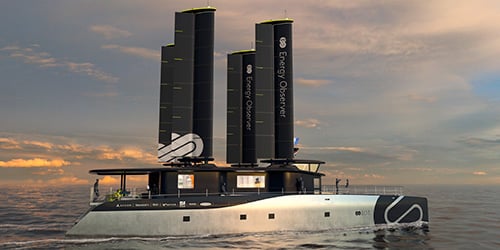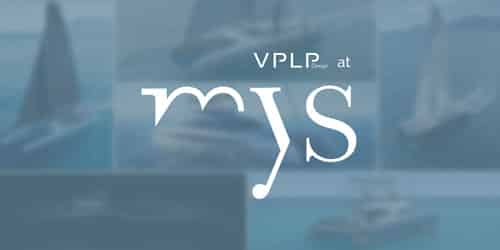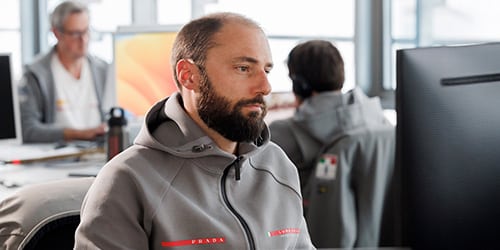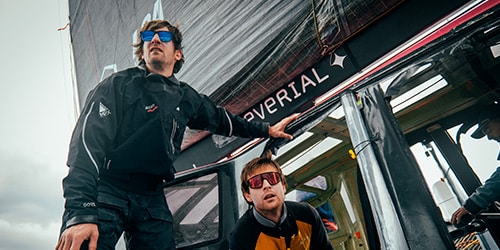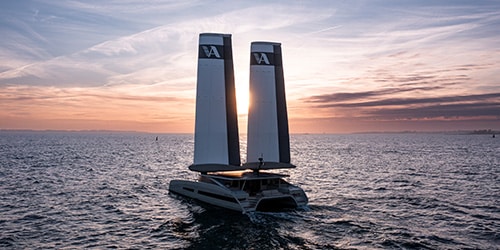Forty sailors will be lining up at the start of the tenth Vendée Globe on 10 November. Among them, 13 (*) will be sailing an IMOCA designed by VPLP Design (including 9 in collaboration with Guillaume Verdier). The history between the naval architecture firm and the solo round-the-world race began back in 2008. Since then, IMOCA architecture has developed considerably. Let’s take a look.
2008: Safran, the pioneer
VPLP Design’s history in racing had mostly been about multihulls until the firm decided in 2008 to make the leap to the IMOCA class for the sixth edition of the Vendée Globe.
“Our getting involved was motivated by the arrival of Marc Guillemot in the class,” says Quentin Lucet, Partner Naval Architect at VPLP Design. “He wanted to try a different approach and presented to Safran, his sponsor, a new design team. This included VPLP, already massively experienced in ocean multihulls, and Guillaume Verdier who had considerable experience with IMOCAs and had spent the previous decade working with Jean-Marie Finot. Safran was attracted to the innovative aspect of the project.”
This collaboration led to the 2007 launching of Safran, the very first VPLP/Verdier design (and sister ship to Groupe Bel). She differed from the other designs in the class by her taut lines and hard chines, but above all she was much lighter (7.5 tonnes).
“The goal was to produce a powerful yet light boat, hence the hard chine to generate power,” explains Quentin Lucet. “As for her weight, we did an enormous amount of work to lighten her structure. We collaborated with Safran Engineering Services which placed resources at the disposition of the project.”
Even back then, VPLP Design was looking ahead to the next innovations: “On Safran, we started trying out C-shaped centreboards to generate lift when the boat was heeling. You could say we were taking the first steps towards foils.”
VPLP/Verdier designs for Vendée Globe 2008: Safran (Marc Guillemot, 3rd), Groupe Bel (Kito de Pavant, retired).
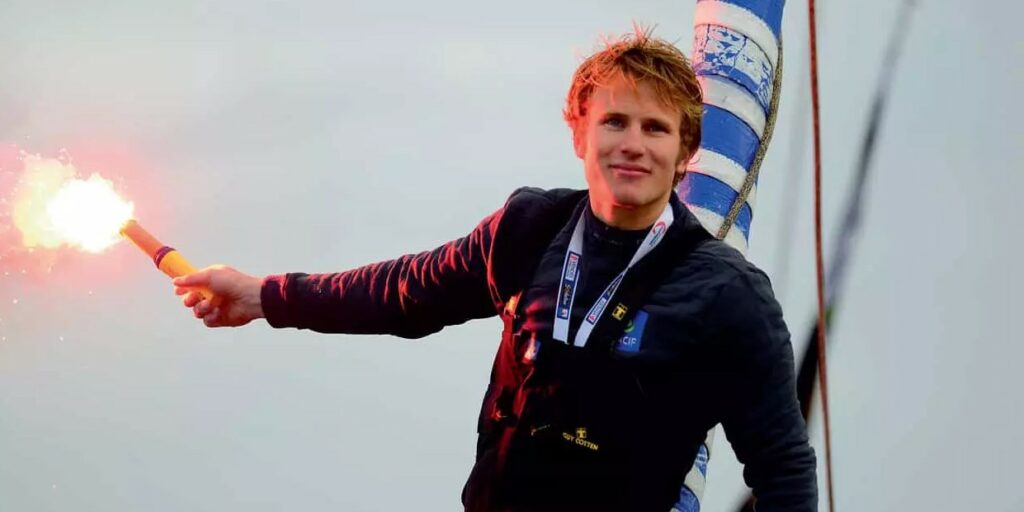
© Vincent Curutchet / Macif
2016: The advent of foils and two wins in a row
The eighth edition of the Vendée Globe was marked by an architectural revolution with the appearance of foils in the IMOCA class, an innovation proposed by team VPLP/Verdier.
“There were a lot of discussions in 2013 about the class rules,” explains Quentin Lucet, “including proposals to reduce the number of ballast tanks and to standardize the masts and keels, components which we worked on considerably to raise performance. This forced us to look elsewhere for solutions to generate power, without increasing the weight of the boat too much. The logical continuation in the quest for lifting force was foils.”
Logical, undoubtedly, but customers had to be reassured, such as Armel Le Cléac’h who won the 2016 Vendée Globe on one of the then new VPLP/Verdier foilers launched in 2015.
“When the proposal was put on the table, we asked for some convincing figures,” recalls the Banque Populaire VIII skipper. “We also ran some trials of our own using a Mini that we fitted small foils to, and which led us to validate the decision.” Proof that the innovation was a bold one, the participating architects designed hybrid boats that could compete with or without foils.
“As we weren’t sure that it would work, we gave ourselves the possibility to fall back on a more traditional set up,” says Quentin Lucet. “The foils were small, weighing 90 kg compared to the 300–320 kg of today, and there were quite a few phases where we counted on the hull and the ballast tanks to generate the righting force.”
However the results spoke for themselves because two VPLP/Verdier designs of the new generation took the first two places in the race. To quote Armel Le Cléac’h: “There is a clearly a before and after.”
VPLP/Verdier designs for Vendée Globe 2016: Banque Populaire VIII (Armel Le Cléac’h, 1st), Hugo Boss (Alex Thomson, 2nd), Paprec St Michel (Jean-Pierre Dick, 4th), No Way Back (Pieter Heerema, 17th), Edmond de Rothschild (Sébastien Josse, retired), Safran (Morgan Lagravière, retired).

2020: Flying boats and a third win
Foils having proved themselves in racing conditions, the architects at VPLP Design, this time without the collaboration of Guillaume Verdier, moved the dial further for the next generation. VPLP responded to requests from skippers of existing boats to design larger foils, and started to design new hulls specifically for these appendages.
“We really made the transition from ‘a boat with foils’ to ‘a foiler’,” says Quentin Lucet. “The foils on the first one to go in the water, Charal (launched in August 2018), were three times the size of the 2016 generation! I remember the first Défi Azimut, with Charal’s stern gliding one metre above the water. In terms of attitude, it was a different world.”
Now the priority was to make the IMOCAs fly, which meant designing different hulls. “The goal was to limit drag. This meant that the chines would be softer, the hulls narrower and more rounded, more volume in the bow and much less wetted surface.”
A year after Charal came a new VPLP design: Hugo Boss. Tailored for Alex Thomson, this new boat featured an enclosed cockpit, yet another revolution.
“Alex was on his seventh boat and fifth Vendée Globe,” explains Antoine Lauriot Prévost, who joined VPLP Design after the 2016 Vendée Globe. “He had clearly identified objectives, such as the desire to be completely protected from the elements. He also wanted foils designed very specifically for reaching.” At the start of the 2020 edition, everyone was predicting total domination for this new generation of foilers, and yet the winner was a 2016 VPLP/Verdier design, Maître Coq IV (formerly Safran), skippered by Yannick Bestaven.
“Excluding the technical problems which affect every mechanical sport, we really didn’t see the disruptive innovation we were expecting,” says Quentin Lucet. “In theory, we were seeing performance deltas of 4 knots, but that advantage was completely wiped out in the southern ocean. Sailing solo, the skippers weren’t able to exploit the speed potential of their boats in conditions, in particular sea states, that they hadn’t encountered on transatlantic passages. The preceding generation even managed to maintain a steadier pace.”
VPLP designs for Vendée Globe 2020: Charal (Jérémie Beyou,13th), DMG Mori (Kojiro Shiraishi, 16th), Hugo Boss (Alex Thomson, retired).
2024: Reappraisals and glowing prospects
While the 2020 edition of the Vendée Globe undermined certain convictions, the architects involved intensified their discussions with the skippers in order to better understand the weaknesses of the foilers in the Southern Ocean. At VPLP Design, we also took the decision to get out on the water more. For example, in 2021 Antoine Lauriot Prévost joined Hugo Boss for the return trip from South Africa, and in 2022 and 2023 he completed two transatlantic crossings on Teamwork (formerly Charal).
“Skippers told us that the boats had a tendency to dig in, to bury the bow into the wave ahead,” says Antoine Lauriot Prévost. “After three weeks on Hugo Boss, I had no doubt as to where to place the cursor for Malizia’s hull design.”
What does that mean specifically? “We add a lot of rocker, that is to say curvature to the bottom of the hull, to give the boat a rising attitude. This gives more height to the bow and thus reduces, even cancels out, the abrupt decelerations as the bow hits the wave ahead.” Given Boris Herrmann’s extremely dense sailing schedule between 2022 and 2024 (including The Ocean Race), emphasis was placed on the robustness of the boat, and therefore her structure, while the foils were designed to be versatile. Also, ergonomics were a core consideration in numerous aspects of the design, with an inverted layout compared to many boats, the cockpit being placed just behind the mast and the living area extending aftward.
“In addition to a better centring of the weight,” says Antoine Lauriot Prévost, “moving the cockpit forward allows for greater headroom below deck, so the crew can stand upright, which is a big plus compared to cockpits which force you to bend double. And having the living area further aft makes things a little less uncomfortable.”
Boris Herrmann scheduled the launch for the summer of 2022, and since then the design choices have proved their worth. Boris scored a remarkable victory in the third leg of The Ocean Race, in the Southern Ocean. He broke the 24-hour distance record for monohulls on the leg between Newport and Aarhus (641.13 nautical miles, at an average speed of 26.71 knots). And he also achieved second places in The Transat CIC and the New York to Vendée in May and June 2024. Does this make Malizia a favourite for the tenth edition of the Vendée Globe?
“The results and Boris’s own feelings on the matter have confirmed our design choices, but when it comes to the Vendée Globe, we have learnt to remain humble,” says Quentin Lucet who, alongside all the team at VPLP Design, is already working on the 2028 generation.
VPLP design for Vendée Globe 2024: Malizia-Seaexplorer (Boris Herrmann)
(*) The 13 VPLP and VPLP/Verdier IMOCAs competing in the 2024 Vendée Globe
| Generation | Boat | Skipper | Launch | Architect |
|---|---|---|---|---|
| 2024 | Malizia – Seaexplorer | Boris Herrmann | 2022 | VPLP Design |
| 2020 | Dmg Mori Global One | Kojiro Shiraishi | 2019 | VPLP Design |
| 2020 | Hublot | Alan Roura | 2019 | VPLP Design |
| 2020 | Teamwork-Team SNEF | Justine Mettraux | 2018 | VPLP Design |
| 2016 | Fortinet – Best Western | Romain Attanasio | 2015 | VPLP/Verdier |
| 2016 | Guyot Environnement – Water Family | Benjamin Dutreux | 2015 | VPLP/Verdier |
| 2016 | Medallia | Pip Hare | 2015 | VPLP/Verdier |
| 2016 | Prysmian | Giancarlo Pedote | 2015 | VPLP/Verdier |
| 2016 | Groupe Apicil | Damien Seguin | 2015 | VPLP/Verdier |
| 2012 | Monnoyeur – Duo for a job | Benjamin Ferré | 2011 | VPLP/Verdier |
| 2012 | La Mie Câline | Arnaud Boissières | 2010 | VPLP/Verdier |
| 2008 | MS Amlin | Conrad Colman | 2007 | VPLP/Verdier |
| 2008 | MACSF | Isabelle Joschke | 2007 | VPLP/Verdier |
